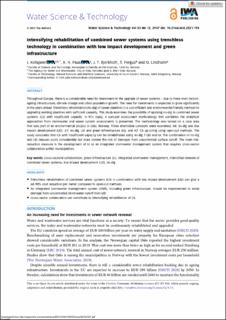| dc.contributor.author | Kvitsjøen, Julia | |
| dc.contributor.author | Paus, Kim Aleksander Haukeland | |
| dc.contributor.author | Bjerkholt, J.T. | |
| dc.contributor.author | Fergus, T. | |
| dc.contributor.author | Lindholm, Oddvar G. | |
| dc.date.accessioned | 2022-03-24T13:06:43Z | |
| dc.date.available | 2022-03-24T13:06:43Z | |
| dc.date.created | 2021-08-06T18:04:03Z | |
| dc.date.issued | 2021 | |
| dc.identifier.citation | Water Science and Technology. 2021, 83 (12), 2947-2962. | |
| dc.identifier.issn | 0273-1223 | |
| dc.identifier.uri | https://hdl.handle.net/11250/2987399 | |
| dc.description.abstract | Throughout Europe, there is a considerable need for investment in the upgrade of sewer systems – due to three main factors: ageing infrastructure, climate change and urban population growth. The need for investments is expected to grow significantly in the years ahead. Trenchless rehabilitation (no-dig) of sewer pipelines is a cost-efficient and environmental friendly method for upgrading existing pipelines with sufficient capacity. This study examines the possibility of applying no-dig to combined sewer systems (CS) with insufficient capacity. In this study, a concept assessment methodology that combines the analytical approaches from stormwater and sewer system assessments is presented. The methodology was tested on a case area that was part of an environmental project in Oslo, Norway. Three alternative concepts were examined; A0: no-dig and low impact development (LID), A1: no-dig, LID and green infrastructure (GI), and A2: CS up-sizing using open-cut methods. The study concludes that CS with insufficient capacity can be rehabilitated using no-dig if LID and GI. The combination of no-dig and LID reduces costs considerably but does involve the risk of damages from uncontrolled surface runoff. The main risk-reduction measure is the development of GI as an integrated stormwater management system that requires cross-sector collaboration within municipalities. | |
| dc.language.iso | eng | |
| dc.title | Intensifying rehabilitation of combined sewer systems using trenchless technology in combination with low impact development and green infrastructure | |
| dc.type | Peer reviewed | |
| dc.type | Journal article | |
| dc.description.version | publishedVersion | |
| dc.source.pagenumber | 2947-2962 | |
| dc.source.volume | 83 | |
| dc.source.journal | Water Science and Technology | |
| dc.source.issue | 12 | |
| dc.identifier.doi | 10.2166/wst.2021.198 | |
| dc.identifier.cristin | 1924502 | |
| cristin.ispublished | true | |
| cristin.fulltext | original | |
| cristin.qualitycode | 1 | |
